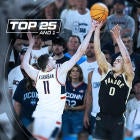In the spirit of the holiday season, I am presenting you with the gift of a new bracket. I'm sorry, but not returns are allowed. All brackets are sold "as is."
This is the first bracket that has relied on the new NCAA Evaluation Tool (NET) as the primary source of data. Although, as is always the case with mid-December brackets, the data is not always reliable. That was always true of the RPI because it started everyone at zero and there still are not that many games played by each team. The NET may be more sophisticated – who knows? – but it still starts everyone at zero.
A couple of my preseason No. 1 seeds have fallen off the top line of the bracket. Michigan and Tennessee are the new teams with top seeds.
[Bracketology: Palm's complete bracket, 1-68 seed list and first four out]
My preseason overall No. 1 was Duke, but a loss to Gonzaga has pushed the Blue Devils down to the top No. 2 seed.
The team that has fallen farthest is Kentucky. The Wildcats are one of the teams that have benefitted most from the margin of victory component of the NET, but that cannot hide the fact that UK has played only two teams in the top two tiers and lost them both. The Wildcats were humiliated by Duke to start the season and lost in overtime to Seton Hall. Their best win has come over UNC Asheville and all of their wins have come at home.
The NCAA selection committee is still afraid to release the super-secret NET formula, but we are still able to learn some things from the early release of the data. One that stands out, but should not be surprising, is that the uncapped margin of victory factor is strong.
The second most important of the five components is net efficiency. That is defined as a team's offensive efficiency (points per possession) – its defensive efficiency. It's a stat that nearly mirrors a team's margin of victory. Net efficiency correlates stronger with the NET ranking than any of the other known factors, which is not surprising since it is the most weighted of the known inputs to the formula.
We have no idea how to calculate the most important factor of the NET, which is the Team Value Index, but it uses the same data that the RPI did for each game – who you played, where you played them and if you won. However, it is the net efficiency component that largely separates this new system from the RPI.
Teams that are doing well in net efficiency are largely doing much better in the NET than they would have in the RPI. As I said above, Kentucky is one of those. The Wildcats are 12th in net efficiency, but is ranked only 115th in the RPI. Net efficiency has carried to a top 30 ranking in the NET.
North Carolina State is the biggest benefactor from the inclusion of net efficiency. The Wolfpack is the second ranked team in that component, which has helped lift them to rank 16th in the NET. In the RPI, NC State would be way down at 136th.
Texas Tech is the only undefeated team that has won all of its games by double digits. Even though Nebraska is the only team in the top two tiers that the Red Raiders have played so far, the perfect high net efficiency, and surely the maxed-out capped margin of victory component, have Texas Tech fourth in the NET.
Looking the other way, Minnesota is 15th in the RPI, but doesn't crack the top 50 of the NET. The Gophers' net efficiency is barely in the top third of Division I.
These are a few of the more extreme examples. However, one thing I have noticed is that the old RPI correlates every bit as strongly to the NET ranking as net efficiency does. That is more trivia than anything else because the RPI is not part of the new formula, as far as we know. So, while there are some cases of wild differences, so far at least, the old and new are tracking together pretty well.





























